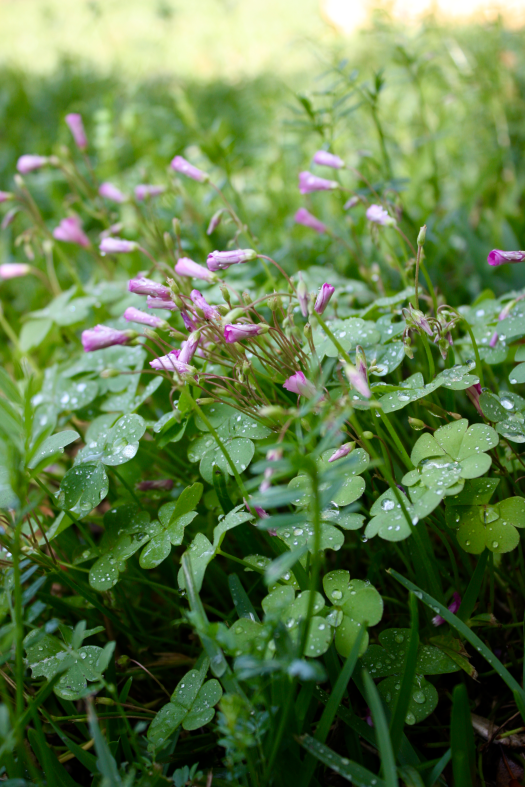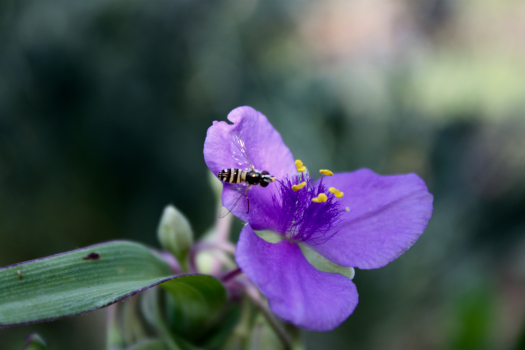We are first time homeowners. Last January, we bought our little brick house sitting on 1/4 acre of property. Moving from a small apartment in a more urban downtown area, we didn’t own a lawnmower. During those first winter months, it was no problem. “The grass grows so slowly anyway!” I remarked one afternoon as I walked across dormant grass (ignorance is bliss). We left for a trip to Nicaragua for 10 days right on the cusp of spring. When we returned, we discovered that our once slightly brown yard had bursted to life. Milk thistle, dandelions, watercress and winter cress, spiderwort, dollar weeds, crimson clover, and vetch had awakened from the ground and were thriving in our balmy backyard.

Clovers and Common Vetch covered in morning dew. Both plants are known to repair nitrogen in the soil.
At the time, I was exactly halfway through my Permaculture Design Course. One of my instructors was a passionate herbalist and she sprinkled our lessons with tidbits about the benefits of many of these wild plants. I became entranced with these wild weeds: the volunteer pioneers in the land’s natural process of succession. Nature doesn’t like bare soil. These plants were filling in the dead parts of our lawn, some (such as the clovers and vetch) were even working to restore nitrogen levels in the soil. The flowers were attracting beneficial pollinators.

A hoverfly paying visit to a Spiderwort flower beside one of my herb beds. These blooms are abundant in my yard at the moment.
Of course, the grass continued to grow and the wild plants in our garden began to become a bit too tall to comfortably run around the yard with our dog, Maya. We were in the process of sheet mulching (a simple no-till method involving the use of cardboard to act as a grass/weed barrier to build a garden above the native soil), but we still wanted some open space. (Side note: I read an interesting theory recently from an ecologist, John Falk, who has studied lawns for many years. He, and other scientists, believe that humans have a preference for savannah-like terrain similar to conditions in East Africa. The concept is that as a species, we have spent nearly 90% of human history in this environment and the predilection for this type of landscape could be genetic.)
After reading a tremendous amount of information during my PDC about the importance of building our depleted soil with organic matter, along with the knowledge of the detrimental effects of weed killers like Round-Up, I refused to pour any type of toxic chemical onto my land. I decided instead to just regularly mow the grass (on a tall setting, having it mulch as I go), letting these wild weeds remain amongst the grass. I know this may not be a crazy concept to any organic gardeners out there, but many people have become so preconditioned to applying chemicals to their lawn that they most likely don’t pause before grabbing a bottle of liquid-bee-death off the shelf from their local home improvement store.

Crimson Clover growing on my front lawn, a beautiful nitrogen-fixer and an early spring food source for the bees.
I’ve come to really love my wild lawn. I marvel at the plants who volunteer to pop up in the soil. Of course, some are invasive (kudzu!) and I work to quickly pull up unwanted plants at first sight. Early in the morning, I bring my field guides outside and walk the garden, learning slowly as I identify new species.
It’s funny, I even get compliments on our grass now! I always tell people it’s because I am building healthy soil: by leaving fallen oak leaves in place to mulch, by setting the mower to drop the grass clippings, and with big help from many of the beautiful wild weeds that are pumping nitrogen and other trace minerals into the ground beneath our feet!

I love this blog! It’s so informative. I’m hoping little by little I can apply it to my space.
LikeLiked by 1 person
Thanks for reading! Keep me updated on your yard this summer!
LikeLike